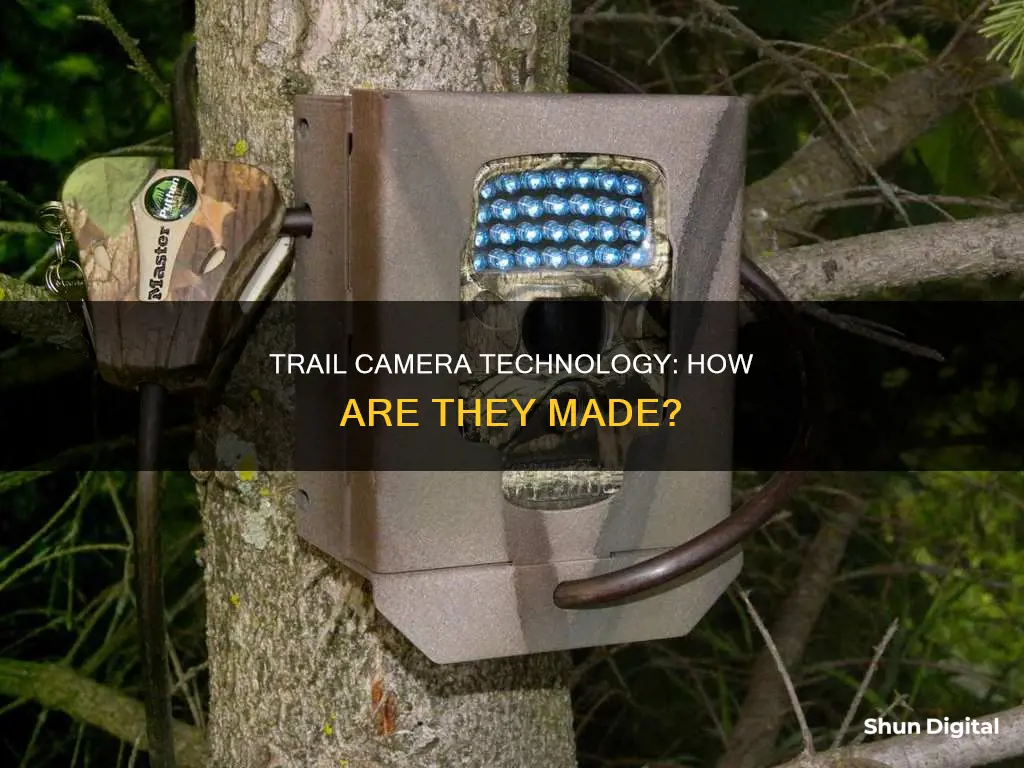
Trail cameras are motion-activated devices designed to capture images and videos of wildlife in their natural habitat. They are equipped with motion sensors and infrared technology, enabling them to automatically capture footage when triggered by movement. The basic components of a trail camera include a camera, an infrared flash, a PIR motion sensor, a lux meter, control buttons, and a display. They are typically powered by batteries and store footage on memory cards, but can also be connected to external power sources and transmit data via cellular networks.
| Characteristics | Values |
|---|---|
| Purpose | Monitoring wildlife and capturing wildlife activity in outdoor environments |
| Functionality | Motion-activated, weatherproof, infrared technology, cellular connectivity, memory storage |
| Power Source | Batteries (rechargeable or non-rechargeable), external power sources (solar panels, external battery packs) |
| Features | Detection ability, trigger time, recovery time, lens type, flash/illuminator, picture/video quality, memory card, remote access |
| Use Cases | Wildlife research, hunting, security, property surveillance, vandalism prevention |
What You'll Learn

Trail cameras are motion-activated
The PIR sensors in trail cameras contain infrared radiation-sensing elements that are typically housed in a metallic case mounted on the camera's circuit board. These sensors are made of a material sensitive to infrared radiation and are placed behind optical filters or "windows," which allow them to detect motion within a specified distance known as the detection distance. When the sensor detects equal amounts of infrared radiation, the camera remains inactive. However, when there is a change in the relative infrared radiation, triggered by motion and heat, the camera is activated.
The detection angle and distance of trail cameras refer to the angle and distance at which the camera's PIR sensor can recognise motion, heat, and infrared radiation to record a trigger event. The detection angle can be influenced by the design of the Fresnel lens, a small black curved piece of plastic that works in conjunction with the PIR sensor. The Fresnel lens condenses light, providing a larger range of infrared radiation to the sensor and dividing the detection area into broader zones.
The trigger speed of a trail camera refers to the time lapse between the detection of motion and the capturing of a photo or video. A fast trigger speed is crucial for ensuring that the camera captures complete images of animals and reduces the number of blank photos. Additionally, a fast trigger speed is particularly useful when setting up the camera on a trail during the rut or in areas with high wildlife activity.
In summary, trail cameras are motion-activated devices that utilise PIR sensors and Fresnel lenses to detect and capture images or videos of wildlife. The motion-activation feature, along with the camera's detection angle, distance, and trigger speed, ensure efficient and effective monitoring of wildlife without constant human presence.
Softening Skin Tones in Camera Raw: A Guide
You may want to see also

They use infrared technology
Trail cameras are motion-activated cameras designed to capture images and videos of wildlife in their natural habitat. They are equipped with motion sensors and infrared (IR) technology, which enables them to capture images and videos in low-light or night-time conditions without disturbing the wildlife. This technology is known as infrared flash.
Infrared light is invisible to humans and animals, and it is emitted by infrared LEDs (Light Emitting Diodes). When the camera detects motion or heat, these LEDs illuminate the scene, allowing the camera to capture clear black-and-white images or videos in the dark. This is particularly useful for wildlife photography and surveillance, as it does not disturb the natural behaviour of the animals.
There are two types of infrared flash: red glow infrared and no glow infrared. Red glow infrared cameras produce a faint red glow when taking a photo or video at night, while no glow infrared cameras are invisible to the human eye. No glow infrared cameras are ideal for security and other covert applications as they do not spook the game.
Infrared trail cameras have become increasingly popular for wildlife surveillance and security due to their ability to capture clear images and videos without disturbing the subject. They are also used for home security and indoor surveillance.
When choosing an infrared trail camera, it is important to consider the image quality, trigger speed, and other features such as remote access and wireless transmission. It is also crucial to check the regulations in your state regarding the use of trail cameras, especially when used on public land or for hunting activities.
Charging Your Lumix Camera Battery: No Charger Required
You may want to see also

They are weather-resistant
Trail cameras are weather-resistant, designed to be left outdoors and unattended for extended periods. They are built to withstand harsh weather conditions, including heavy rains, snow, and even total submersion in water. This is achieved through the use of ingress protection (IP) ratings, which indicate the level of protection offered by the camera against solids and liquids.
The two most common IP ratings for trail cameras are IP56 and IP66. A trail camera with an IP56 rating has a protection level of 5 against solids and 6 against liquids. This means that while small amounts of dust may enter the camera, it won't be enough to interfere with its operation. The camera is also protected against powerful water jets, ensuring that heavy rain or snow won't penetrate the outer case.
An IP66 rating, on the other hand, indicates a higher level of protection against solids, with complete protection against dust ingress. The protection against liquids is the same as IP56, safeguarding the camera from powerful water jets.
While trail cameras are not completely waterproof, they are weatherproof, able to withstand various weather conditions without failing. This makes them suitable for continuous outdoor use, providing valuable insights into wildlife behaviour and helping hunters track their prey.
Editing Midtones in Camera Raw: A Step-by-Step Guide
You may want to see also

They can be wireless
Wireless trail cameras, also known as cellular trail cameras, are two-way communication devices that function similarly to cell phones. They are designed to transmit images and videos to a cloud-based server via cellular networks or WiFi, allowing users to receive real-time alerts and notifications on their mobile devices.
To enable wireless functionality, trail cameras require both an outbound and an inbound signal, just like cell phones. The strength of the signal depends on the camera's proximity to the nearest cellular tower and any obstacles that may impede the signal, such as dense foliage in heavily wooded areas. When a strong cellular signal cannot be established, the camera will default to operating like a traditional digital camera, storing images and videos on a memory card.
Most cellular trail cameras rely on the global system for mobile (GSM) networks and require a SIM card to connect to the network. Users need to register and activate the SIM card with their chosen mobile network provider. Additionally, trail camera manufacturers have started offering wireless services specifically tailored for trail cameras, providing users with more options for connectivity.
It is important to note that wireless trail cameras typically incur additional costs for mobile data plans or WiFi connectivity. While they offer the convenience of instant alerts and remote access, the image quality of wireless trail cameras may not be as high as that of their non-wireless counterparts, with lower resolution and image quality.
Wireless trail cameras are a popular choice for hunters, nature enthusiasts, and wildlife photographers. They provide instant updates, allowing users to track wildlife activity remotely and make informed decisions about their hunting strategies or research projects.
Analog Cameras: Still Relevant, Still Made?
You may want to see also

They can be solar-powered
Trail cameras are an excellent tool for monitoring wildlife and capturing images and videos of animals in their natural habitat without disturbing them. These cameras are equipped with motion sensors and infrared technology, enabling them to capture images or videos automatically when triggered by movement. While traditional trail cameras typically use batteries as their power source, an innovative and eco-friendly alternative is the use of solar power.
Solar-powered trail cameras offer a range of benefits that make them a compelling choice for outdoor enthusiasts, photographers, and researchers. Firstly, they provide an endless power source, ensuring that your camera can remain operational for extended periods without the need for frequent battery replacements. This is especially advantageous when the camera is placed in remote locations, eliminating the hassle of frequent battery changes.
The solar panels used in these trail cameras are designed to be low maintenance. Once installed, the main requirement is to position them in a location with ample sunlight. Additionally, these panels are built to withstand various weather conditions, from intense heat to freezing temperatures, ensuring reliable performance throughout the year.
Another advantage of solar-powered trail cameras is their versatility. They can be used for a variety of applications, including wildlife photography, hunting, farm security, and even scientific research. The use of infrared LED technology for night vision allows for discreet monitoring, ensuring that animals are not startled and potential trespassers or predators are not alerted.
When choosing a solar-powered trail camera, it's important to consider the solar panel's power rating and the camera's overall power consumption. Additionally, look for cameras with features such as high-resolution image sensors, long-lasting batteries, and easy data access. Some cameras even offer wireless connectivity, allowing for remote access and instant alerts when new footage is captured.
Solar-powered trail cameras are a sustainable and reliable option for anyone looking to capture breathtaking images of wildlife or enhance security around their property. With their low maintenance and versatile design, these cameras offer an endless power supply, ensuring uninterrupted operation and capturing those once-in-a-lifetime moments.
Auto Mode: Your Camera's Smart Default Setting
You may want to see also
Frequently asked questions
There are ten key features of trail cameras to consider: the ability to detect animals, trigger-time, recovery-time, lens, flash/illuminators, picture/video quality, picture/video settings, memory (SD) card, power supply, and other bells and whistles.
Trail cameras are designed to exist in a state of almost complete electronic sleep, with only the motion-sensor fully awake. When the motion-sensor detects movement, it triggers a rapid chain of events: light levels are detected and the flash turned on accordingly; focus is achieved; shutter speed is determined; one or more pictures or video are taken by the image-sensor; pictures/video are stored on an SD card; the camera goes back to sleep.
Trail cameras typically use batteries as their power source. They are commonly powered by lithium AA batteries or rechargeable batteries. Some models also offer the option to connect to external power sources such as solar panels or external battery packs for extended operation.







